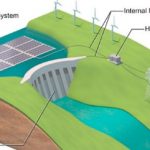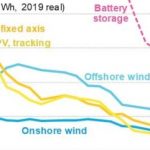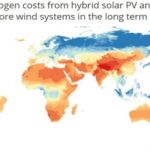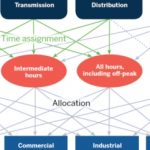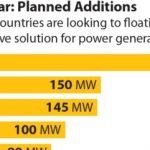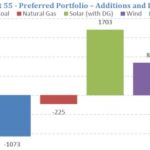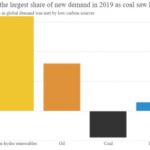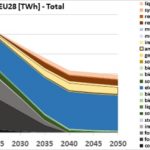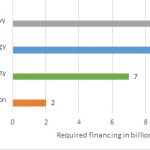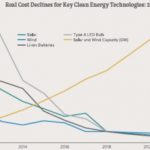The idea is simple. Float solar panels on the reservoirs of hydroelectric dams. The new solar can piggy back on the existing grid connections. They complement each other by being strong when the other is weak: solar for the dry season, hydro for the wet. The hydro can provide pumped storage for the excess solar. Finally, the reservoir is readily available space. A team at the U.S.'s National Renewable Energy Laboratory have calculated the … [Read more...]
Perovskites: the next generation of solar cells and lighting?
Enthusiasm about the discoveries being made about perovskite materials is spreading, explains Sam Stranks at the University of Cambridge. Perovskite solar cells hit 25.2% efficiency in 2019, not far off crystalline silicon cells at 26.7%. Research is suggesting that figure could rise higher still. Perovskite can be “tuned” to absorb particular frequencies of light, allowing different layers of perovskites to absorb different and therefore more … [Read more...]
No more “offsetting”: Google commits to 24/7 locally sourced carbon-free electricity by 2030
By “offsetting” fossil electricity consumed at one data centre through buying green power from somewhere else, Google has been 100% renewable since 2017. But offsetting always has its flaws. In this case, 40% of Google’s actual power still comes from fossil fuels. Google’s new plan, to be 100% green 24/7 straight off the local grid, is designed to solve that. It will also send market signals to increase clean capacity locally, not just where you … [Read more...]
Grid scale Battery costs are declining faster than Wind and Solar
Gas as a transition fuel for grids may be around for a lot less time than we thought. We already know that large batteries, if they are cheap enough, can replace gas plants to provide peaking power to grids reliant on intermittent wind and solar. Bruce Robertson at IEEFA says the numbers are showing battery costs declining even more rapidly than wind and solar. Precisely because of that increased competitiveness Australia’s AGL Energy is starting … [Read more...]
Will Saudi Arabia build the world’s largest green hydrogen and ammonia plant?
The Gulf is already a major producer and consumer of hydrogen, mainly for fertilisers and specialty chemicals. Like most hydrogen produced globally, it is the ‘grey’ kind made from hydrocarbons. But the region’s low renewable power costs and abundance of land give it the key components for the industrial scale production of green hydrogen. So in July, the Saudi model city of Neom (Neom means “new future”) and ACWA Power signed a joint venture … [Read more...]
Who will be the Hydrogen superpower? The EU or China
Implicit in the EU’s plans, announced in July, to be the world’s Hydrogen leader is that this technology will have others competing for the top spot too. When EU nations ramped up their solar PV sector in the 2000s they couldn’t survive the arrival and rapid expansion of Chinese production. Will EU Hydrogen meet the same fate? Sören Amelang at CLEW speaks to a wide range of experts to try to answer this vital question from all the relevant … [Read more...]
The new era of electricity needs modern ways to charge customers
Today’s technologies – wind, solar, storage - have widely differing cost and operating characteristics to fossil fuels. So the way customers are made to cover those costs – assigning different rates to different customer classes – should change. Jim Lazar and Mark LeBel at RAP explain why and how, referencing their comprehensive manual “Electric Cost Allocation for a New Era”. They describe how the full range of technologies now establishing … [Read more...]
Floating Solar: can it help ASEAN reverse coal’s continued rise?
Floating solar farms may be gaining traction in Asia. Capacity is still small: by 2019 the big players Japan and China had a combined floating photovoltaic (FPV) installed capacity of 1.3GW. But the ASEAN countries that had virtually nothing before 2019 now have over 51MW and have planned in another 858MW. A report by Sara Jane Ahmed and Elrika Hamdi at IEEFA explains why FPV is looking better and cheaper at balancing out peaks and troughs than … [Read more...]
Three U.S. utilities to skip the gas “bridge”, move straight from coal to renewables
At the end of June, utilities in three U.S. states declared they are closing down coal plants and moving straight to renewables, without building new gas plants as a “bridge” fuel. For example, to replace lost coal capacity, Tucson Electric Power in Arizona will add 2,457MW of new wind and solar generation, backed up with 1,400MW of battery storage. Similar commitments are being made by other utilities in Colorado and Florida. New Mexico is … [Read more...]
BP’s world energy review: 2019 saw clean electricity match coal
Simon Evans at Carbon Brief summarises BP’s 69th edition of its influential annual statistical review of world energy, looking at 2019. Overall, total energy demand rose, though slower than usual. Renewables were the largest source of new energy, but were closely followed by oil and gas. Coal use dropped again, the fourth drop in six years, thanks to historic declines in the EU and the US. But continued growth in SE Asia, China and India leaves … [Read more...]
The PAC Scenario: net-zero by 2040 to meet Europe’s Paris goals
The EU is not on track to meet its Paris Agreement obligations on emissions and limiting the global temperature rise to 1.5°C. CAN Europe and the European Environmental Bureau (EEB) present their Paris Agreement Compatible (PAC) scenario, designed to do just that. It’s been created through the careful analysis of contributions from more than 150 stakeholders including NGOs, scientists, industry and grid operators. Jörg Mühlenhoff at CAN Europe … [Read more...]
“Green” chemical plants that ramp up and down with wind, solar
One solution to variable renewables is to create customers that have no problem with ramping up and down production along with the power. In fact, when the wind and solar is producing too much power for the grid it can be bought very cheaply, making intermittent customers very happy. Jim Conca describes a new design for a Chlor-Alkali Chemical Plant that can “idle” without critical components of the plant degrading – the main reason for a plant … [Read more...]
Germany’s Corona stimulus package: what’s in it for energy, climate?
€30bn of Germany’s €130bn Corona economic stimulus package is dedicated to the energy sector and the climate. Simon Göss at Energy Brainpool runs through the four main areas of focus. There’s €11bn to fund a reduction in the EEG levy (renewables surcharge) to help electricity consumers. €9bn goes to creating a hydrogen industry for Germany. There’s €7bn to promote e-mobility (tax exemptions, subsidies, co-financing of charging stations and … [Read more...]
Tipping Points reached for Solar, Wind, Batteries, EVs. What of the other Clean Energy techs?
History shows a disruptive technology’s tipping point can be under 5% of market share, that’s all it takes. The number of horses in use peaked in the U.S. once car ownership reached 3%. Gas lighting in the UK peaked with electric lighting at just 2% of the market. Landline phones in the U.S. fell precipitously after mobiles captured 5% of the market. Ji Chen and Koben Calhoun at RMI argue the tipping point has already been passed for solar, wind, … [Read more...]
Grid-scale Solar PV storage can use re-purposed old EV batteries
Once an EV battery has declined to 80% of its original capacity it is considered too weak for continued vehicle use. Recycling the battery – at that point - to make another one is expensive. MIT’s David Chandler describes how researchers there have run experiments and models to show that old EV batteries can instead be packed together and used as backup storage for grid-scale solar PV installations. It’s cheaper than building new Li-ion battery … [Read more...]
- « Previous Page
- 1
- …
- 12
- 13
- 14
- 15
- 16
- …
- 20
- Next Page »


